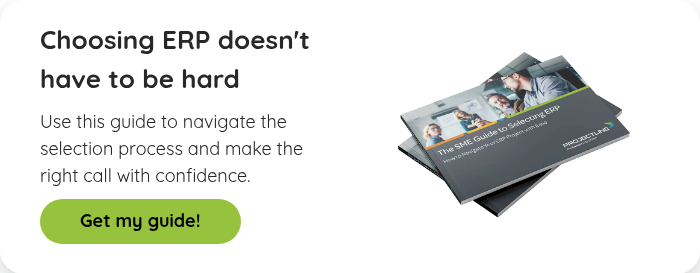Blog
Share this
Top 8 Features SMEs Need in an Inventory ERP System

by Jalene Ippolito on June 26, 2020
For small and mid-size distributors, the move to an ERP system is a major change for the business. Whether you’re coming from a stand-alone inventory management system or you’re still using spreadsheets to track inventory, an ERP inventory management system offers benefits that can take your wholesale business to the next level. With so many solutions to choose from, it can be challenging to zero in on the must-have features. While your ERP requirements will be specific to your business, these are the critical features that your new ERP system should have to improve the way you manage inventory.
1. Inventory control and forecasting
It doesn’t matter if you’re dealing in cosmetics, steel pipes, electronics or parts replacement – your inventory needs ebb and flow based on the demands of your market. For consumer businesses, those ups and downs are often seasonally predictable and easy to confirm. For example, electronics sell big for the holidays, vacation gear for the summer and new clothes fly off the shelves come fall. Other businesses also have inventory cycles, but they aren’t always as clearly visible – at least to the naked eye.
Your ERP inventory management system should give you visibility into demand forecasting, beyond just identifying safe minimum and maximum levels for various items. At a minimum, an ERP solution should track all inventory details, including product specs, product history and stock levels. But don’t stop there. Look for a solution that takes the guesswork out of demand forecasting by calculating required quantities over time and setting re-order points based on anticipated stock levels and vendor lead times.
2. Multi-location management
Even if you currently only have one warehouse to manage, that may change over time as the business expands. Selecting an inventory ERP system that can manage multiple warehouses from a single location gives you flexibility as you grow. The ERP system should allow you to perform instant availability checks and track item stock levels across all warehouses. Also look for a solution that provides multiple costing methods to accommodate your needs.
3. Stock notifications and alerts
When you’re using spreadsheets or less sophisticated tools to manage inventory, you often don’t know about stockouts until they’ve already happened. You’re forced to rely on human intervention to proactively identify issues before they occur. An ERP system gives you complete visibility into your stock levels to avoid these situations. The system should be capable of proactively alerting you to over or under-stocking beyond a defined threshold. This will help you optimize your inventory levels and reduce backorders.
4. Streamlined returns process
A common complaint that our customers have of their old systems is that there’s no easy way to track and process product returns. Your new ERP solution should have a Return Materials Authorization (RMA) process included as standard functionality. This not only allows you to properly track the returned product, but also to process the item based on the return reason. Whether you need to enter it back into inventory or initiate a repair process, your system should allow you to easily manage the return.
5. Advanced purchasing features
Beyond the ability to simply create a purchase order, your new ERP system should help you manage the purchasing process more effectively. From requesting vendor quotes, to creating purchase requests and paying vendors, you should be able to do it all within the system. Also look for a solution that gives you the ability to link purchasing documents and view document trails for audit purposes.
6. Inventory analysis
Improved reporting is one of the biggest drivers for SMEs to upgrade to ERP. You want a solution that has robust standard inventory reporting capabilities. Depending on the scale and complexity of your business, the standard reports may be all you need. But you also want to be sure that you can tailor reports or create custom ones where required. Also look for an ERP system that includes dashboard analytics to give your team actionable insight into your inventory.
7. Flexibility to configure as needed
One of the big drawbacks of inventory management point solutions is that the options to adjust the configuration are limited. Most ERP solutions will give you more flexibility to adapt the system to your processes, but not all are created equal. Tie it back to your business process – think about what you need to accomplish and whether you can do it with standard functionality. If not, look for an ERP system that can be configured to fit your business.
8. Integration and user interfaces
When you invest in an ERP system, you want a solution that will grow as you do. You want a system that can tightly integrate with other best-of-breed applications, like ecommerce. Having your ecommerce site or customer portal integrated directly with your ERP system improves your customer experience and reduces the administrative work for your team to keep everything in sync. And if you have a sales team that works on the road, look for an ERP solution with strong mobile sales apps so they can manage their activity right from their device.
The added advantage of ERP for inventory management
On their own, the inventory management features we’ve discussed can generate significant results for your business. But you'll see the true power of wholesale distribution ERP software across the entire organization. Your sales and purchasing transactions are instantly available for your accounting team, so you can speed up order-to-cash and get better visibility into your financial position. And with an integrated CRM, you have a complete 360 view of your customers and vendors.
We've helped many other North American distributors streamline operations and fuel growth and we can help you do the same. We're here to guide you through the process – right from evaluation, through implementation and beyond.
Share this
Stay in the Know!
Join other SMEs who receive our monthly ERP insights, tips and best practices.
You may also like

ERP Funding for Canadian Businesses

Should You Work with a NetSuite Implementation Partner or Go Direct?



